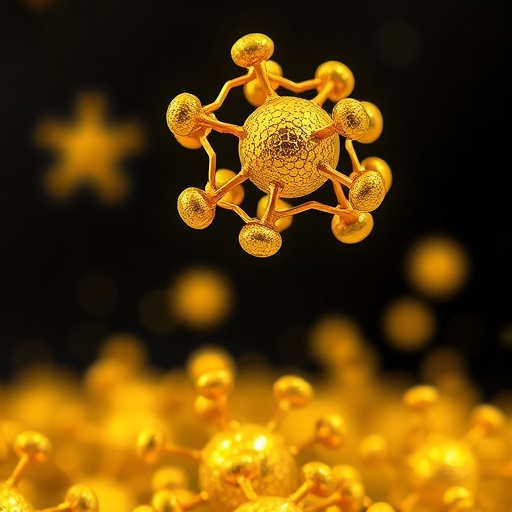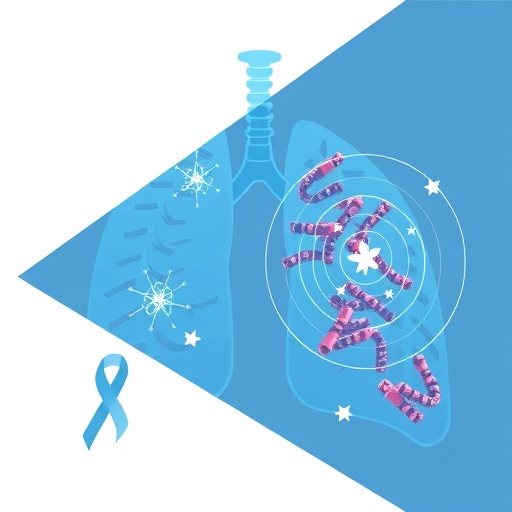
In the rapidly evolving landscape of cancer therapeutics, the integration of nanotechnology with natural compounds has emerged as a beacon of hope for tackling some of the most aggressive and treatment-resistant cancers. A groundbreaking study recently published in Medical Oncology unveils a novel approach employing gold nanoparticles as carriers for chrysin, a naturally occurring bioflavonoid, aimed at combating triple-negative breast cancer (TNBC). This innovative strategy harnesses the unique physicochemical properties of gold nanoparticles, coupled with the formation of inclusion complexes, to optimize the delivery and efficacy of chrysin—offering new avenues for the treatment of a malignancy notorious for its poor prognosis and limited therapeutic options.
Triple-negative breast cancer stands apart from other breast cancer subtypes due to its lack of estrogen receptor, progesterone receptor, and HER2 expression. This distinct profile renders it unresponsive to many targeted hormonal therapies, making chemotherapy and radiation the primary but often insufficient modalities. The urgency for alternative therapies has galvanized researchers worldwide, pushing the boundaries of conventional drug delivery by exploring nanoscale platforms designed to enhance the bioavailability and tumor-selective targeting of anticancer agents. The deployment of gold nanoparticles in this context emerges not merely as a delivery vehicle but as a multifaceted tool capable of traversing biological barriers, protecting payloads, and facilitating controlled release.
The study at hand delves deep into the synthesis and characterization of gold nanoparticles capped with an inclusion complex tailored for chrysin encapsulation. Chrysin, extracted primarily from passionflower and honey, has long been hailed for its anti-inflammatory, antioxidant, and anticancer properties. Nevertheless, its clinical translation has been hampered by poor solubility, rapid metabolism, and limited bioavailability. By engineering a stable inclusion complex—likely involving cyclodextrin or analogous molecular structures—the researchers have devised a mechanism to encase chrysin within a hydrophobic cavity, thereby enhancing its solubility and protecting it from premature degradation.
.adsslot_FHU0v5md4D{width:728px !important;height:90px !important;}
@media(max-width:1199px){ .adsslot_FHU0v5md4D{width:468px !important;height:60px !important;}
}
@media(max-width:767px){ .adsslot_FHU0v5md4D{width:320px !important;height:50px !important;}
}
ADVERTISEMENT
The physical attributes of the gold nanoparticles are critical in dictating their biological interaction. Using advanced techniques such as transmission electron microscopy and dynamic light scattering, the researchers demonstrated that the nanoparticles possess a uniform size distribution within the optimal nanometer range that favors cellular uptake and tumor penetration. The surface capping with the inclusion complex not only stabilizes the nanoparticles against aggregation but also imparts a favorable surface charge that promotes interaction with cancer cell membranes. Such meticulous nanoparticle design ensures that the drug delivery system navigates the challenging tumor microenvironment effectively.
A central focus of the investigation involves assessing the cytotoxic efficacy of the chrysin-loaded nanoparticles against TNBC cell lines in vitro. The results reveal a marked increase in cancer cell apoptosis and growth inhibition compared to free chrysin, underscoring the enhanced therapeutic potential conferred by nanoparticle-mediated delivery. Mechanistic studies suggest that this improved efficacy stems from the increased cellular internalization of the nanoparticles and sustained release of chrysin intracellularly, which potentiates its interference with cancer cell proliferation pathways and induction of programmed cell death mechanisms.
In addition to in vitro studies, the research extends to in vivo evaluations using murine xenograft models of TNBC. Here, systemic administration of the chrysin-loaded gold nanoparticles culminated in significant tumor regression without discernible systemic toxicity, a paramount consideration in chemotherapy adjuncts. Histopathological analyses further corroborated the selective accumulation of the nanoparticles within tumor tissues, a phenomenon attributed to the enhanced permeability and retention (EPR) effect commonly exploited by nanomedicines, along with the potential targeting advantages imparted by the inclusion complex.
The utilization of gold as the nanoparticle core material represents a strategic choice grounded in its biocompatibility, inertness, and ease of surface functionalization. Unlike many metallic nanoparticles that pose risks of oxidative stress or unwanted immune reactions, gold nanoparticles exhibit minimal cytotoxicity and can be synthesized with exquisite control over size and shape. These properties not only facilitate the safe delivery of chemotherapeutic agents but also open doors to synergistic modalities such as photothermal therapy, wherein gold nanoparticles convert light energy to heat, ablation of tumor cells can be achieved.
At the molecular level, the delivery of chrysin via this nanoparticle system appears to modulate critical signaling cascades involved in TNBC pathogenesis. Preliminary data indicate alterations in apoptotic regulators, suppression of angiogenic factors, and inhibition of metastatic markers, collectively impeding tumor progression. Such multimodal interference by a single agent encapsulated within a sophisticated delivery system offers a promising multipronged attack strategy, potentially overcoming the adaptive resistance mechanisms that plague conventional therapies.
One of the highlights of this study is the stability of the gold nanoparticle-inclusion complex formulation under physiological conditions. Stability in biological fluids is essential to prevent premature drug release and aggregation that could cause off-target effects or rapid clearance. The researchers demonstrated that the encapsulated chrysin remains securely bound within the complex during systemic circulation, only releasing in the target environment, likely triggered by pH changes or enzymatic activity characteristic of tumor sites. This targeted release profile enhances therapeutic precision and minimizes collateral damage to healthy tissues.
Furthermore, the modular nature of the inclusion complex capping strategy allows for future adaptations incorporating additional targeting ligands, such as antibodies or peptides that recognize TNBC-specific markers. Such functionalization could amplify tumor homing capabilities, reduce required dosages, and further limit systemic toxicity. This scaffolding approach positions the platform as a versatile tool in the broader nanomedicine arsenal against diverse cancer types.
While the study showcases the immense promise of gold nanoparticle-based delivery of chrysin for TNBC, it also acknowledges hurdles yet to be surmounted, particularly regarding large-scale manufacturing, long-term safety, and regulatory approval. The translation from bench to bedside demands rigorous standardization, thorough pharmacokinetic and pharmacodynamic profiling, and robust clinical trials to validate efficacy and safety in humans. Nevertheless, this research lays a foundational framework stimulating further exploration and refinement.
In the context of a global cancer burden that continues to rise, innovations such as these provide a ray of hope that fatalities attributable to recalcitrant cancers like TNBC can be substantially reduced. By intelligently merging the natural antineoplastic potential of compounds like chrysin with cutting-edge nanotechnology, we are witnessing a paradigm shift in cancer therapeutics, one that emphasizes precision, reduced toxicity, and personalized medicine.
Moreover, the environmental and economic advantages of utilizing naturally derived compounds enhanced by nanoscale delivery cannot be overstated. Chrysin’s origin from plant sources aligns with sustainable pharmaceutical development goals, while nanoparticle platforms promise to improve drug efficacy, reducing wastage, and treatment cycles. Such integrated approaches may redefine the future of oncology, promoting therapies that are not only effective but also environmentally conscientious.
Intriguingly, the findings from this study may also have broader implications beyond TNBC, potentially applicable to other malignancies characterized by poor drug penetration and therapeutic resistance. The adaptable nature of gold nanoparticle-inclusion complexes suggests potential as a universal platform for delivering various hydrophobic anticancer agents, heralding a new era in nanomedicine.
As research continues to unravel the complex interplay between nanomaterials and biological systems, interdisciplinary collaborations will be pivotal in translating laboratory successes into clinical realities. Chemists, biologists, oncologists, and materials scientists must unite to address challenges such as nanoparticle biodistribution, immunogenicity, and long-term fate. The promising outcomes of this chrysin delivery study underscore the incredible possibilities stemming from such collaborative endeavors.
The combination of natural product chemistry, nanotechnology, and cancer biology encapsulated in this pioneering study not only represents a technical milestone but also epitomizes the innovative spirit essential in combating one of humanity’s most formidable diseases. As this therapeutic approach progresses through preclinical and clinical stages, it holds the potential to reshape treatment paradigms for triple-negative breast cancer, transforming lives and inspiring future generations of cancer research.
Subject of Research: Development of gold nanoparticle-based delivery systems for chrysin targeting triple-negative breast cancer.
Article Title: Gold nanoparticles capped with inclusion complex for the delivery of Chrysin in triple-negative breast cancer.
Article References:
Velhal, K., Sah, P., Raut, R. et al. Gold nanoparticles capped with inclusion complex for the delivery of Chrysin in triple-negative breast cancer. Med Oncol 42, 441 (2025). https://doi.org/10.1007/s12032-025-03011-w
Image Credits: AI Generated
Tags: bioavailability enhancement for drugschemotherapy alternatives for TNBCchrysin as a natural anticancer agentgold nanoparticles in cancer therapyinclusion complexes in cancer treatmentnanotechnology in drug deliverynatural compounds in oncologynovel therapeutic strategies for breast cancerovercoming treatment resistance in cancerphysicochemical properties of nanoparticlestargeted therapy for aggressive cancerstriple-negative breast cancer treatment innovations





